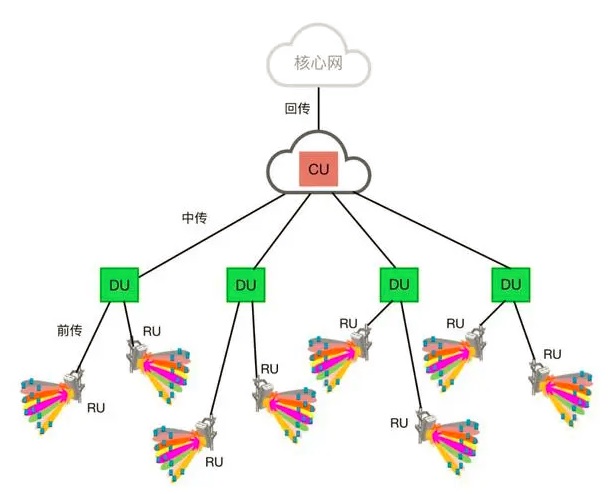USource passive WDM solutions for 5G xHaul RAN
Time:2022-12-23
Views:1885
One of the main challenges in dense 5G xHaul radio access networks (RANs) is provisioning of low-cost connectivity between a large number of antennas, located at remote sites, and a central site (hub) in which baseband processing functions are performed. The wavelength division multiplexing (WDM) is principal transport network technologies enabling the reduction of the demand for direct optical fiber connections of fronthaul (between RU and DU), midhaul (between DU and CU), and backhaul (between CU and a 5G core network). WDM makes it possible to establish a number of such links (using different wavelengths) in a single optical fiber. Additional savings in the amount of fibers required can be achieved by means of optical add-drop multiplexers (OADMs) that allow for obtaining access to unused wavelengths by intermediate remote nodes, whenever the capacity on the WDM system is not fully utilized by the end remote node.
USource offers different passive WDM solutions, CWDM MWDM LWDM and O-band WDM 400GHz 1269.23-1318.35nm.

USource offers different passive WDM solutions, CWDM MWDM LWDM and O-band WDM 400GHz 1269.23-1318.35nm.
Different solutions have been considered for passive WDM networks. Coarse wavelength division multiplexing (CWDM) has been widely used in local and metropolitan networks. In CWDM, the channel spacing equals 20 nm, which enables the use of 18 channels in the wavelength range from 1271 nm to 1611 nm. Due to the wide range of dispersion, CWDM has limited use in systems with an extreme bit rate of 100 Gb/s per wavelength. Zero dispersion of the G.652D fiber lies in the range of 1312±12 nm. For this reason, in the IEEE 802.3cu standard, the wavelength range is limited to 4 channels: 1271, 1291, 1311, and 1331 nm. In China, they expand to 6 channels 1271 to 1371nm. A two times denser spacing, i.e., 10 nm, was proposed in the MWDM system 12 channels were located in the range from 1267.5 to 1374.5 nm. In addition, 12-channel LAN-WDM system (LWDM) with an 800 GHz inter-channel spacing is used, which, in the O-band window, corresponds to a spacing of about 4.5 nm and the center of channels passband equals, respectively, 1269.23, 1273.55, 1277.89, 1282.26, 1286.66, 1291.10, 1295.56, 1300.05, 1304.58, 1309.14, 1313.73, and 1318.35 nm. Recently, an 8-channel system with a 400 GHz channel spacing, i.e., about 2.25 nm in the O band window (called nWDM—narrow WDM) has been proposed, in which the center of channels passband equals, respectively, 1295.56, 1297.80, 1300.05, 1302.31, 1304.58, 1306.85, 1309.14,
and 1311.43 nm. This system, under the trade name of flexiHaul xWave 400G, offers a 20 km transmission distance and a 17 dB power budget. Four-level amplitude modulation (PAM-4) is used, which enables two bits of information to be encoded in one code symbol. Symbols are transferred at 53.125 Gbaud. Forward error correction RS (544,514) is applied to allow error-free transmission for the input bit error rate less than 2.4x10^(4). In the
mentioned WDM systems, multiplexers (MUX), demultiplexers (DMUX), and add/drop modules (OADM), utilizing optical thin-film filters (TFF), are used to extract a channel of a specific wavelength. They have better transmission properties than Bragg grids (FBG) and array waveguide gratings (AWG), especially with inter-channel spacing greater than 200 GHz.







 Copyright 2006-2020 . All Rights Reserved.
Copyright 2006-2020 . All Rights Reserved.